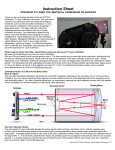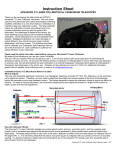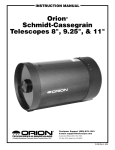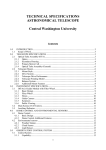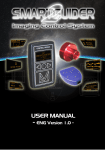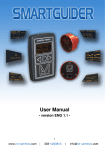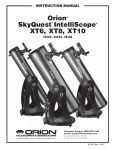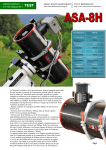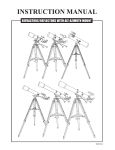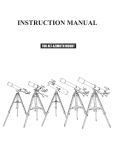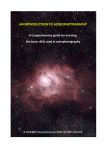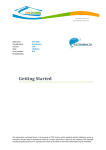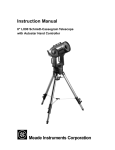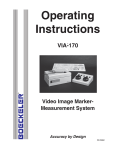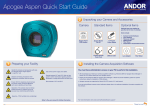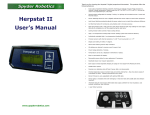Download ACT Laser Collimator Manual V6
Transcript
Instruction Sheet ADVANCED CT LASER COLLIMATOR for CASSEGRAIN TELESCOPES Thank you for purchasing the state-of-the-art HOTECH Advanced CT Laser Collimator instrument. This instrument uses the most advanced laser and optical technology to enable the user to achieve excellent collimation in a very short distance. Collimation is the process of aligning a telescope’s optics. The laser collimator makes the collimation process more efficient and can increase collimation accuracy. Your telescope is aligned at the factory, but harsh handling during shipping can cause misalignment. Some telescopes are not well collimated when shipped. Misaligned collimation can mean lessened of optical efficiency and result in poor image contrast, astigmatism, and blurry images. The following describes how to collimate your Cassegrain style telescope with the aid of the Advanced CT Laser Collimator. Please read the entire instruction sheet before using your Advanced CT Laser Collimator Be aware of the following as you use your Laser Collimator: Only turn ON your laser(s) when you are going to use it. The laser should only be used with adult supervision, and should only be used for collimating a telescope. Never point the laser or the reflection of the laser collimator at anyone's eyes. These instructions cover collimation of Schmidt Cassegrain telescopes, but most Cassegrain type instruments are collimated in similar fashion. For telescopes with both adjustable secondary and primary mirror (e.g. Ritchey-Chretien type telescope), please email or call us for details. All lasers on the collimator are class II (<1mW). For additional information, please visit our website, www.hotechusa.com, or write us at [email protected]. Collimation Basics You Must Know Before Start What to Adjust: The only user accessible collimation adjustment on a Schmidt Cassegrain Telescope is the secondary mirror via three screws. Therefore, you only need to adjust the three alignment screws located at the front of the telescope behind the secondary mirror (see illustration below). For ease of manual adjustment, we recommend replacing the stock alignment screws with knob headed screws (available from several vendors) to allow easier, finer adjustment. How the Collimator Works: The Advanced CT Laser Collimator samples the entire optical system (primary, secondary mirror, and the eyepiece axial position) with a simulated large aperture flat-wavefront light source generated by three parallel lasers positioned behind the target plate. The target plate provides a clear view of the optics’ alignment condition when the three lasers are reflected back on the target (FIG. 1). It is extremely critical that the lasers are pointed square-on (co-aligned) to the primary mirror for an accurate reading. It is just like looking at a distant star and centering the star in the eyepiece field of view during a star test, except the star is about 3 feet in front of the telescope. Advanced CT Laser Collimator User’s Manual (v6), page 1 of 9 To ensure accurate aiming, you use the crosshair pattern projected from the center of the collimator as a guide to the center of the primary mirror (FIG. 2A), and the reflected crosshair from the telescope’s primary mirror for aiming the telescope at the center point of the target (FIG. 2C). Please expect to spend most time on these aiming adjustments. Be patient and careful; the results will be well worth the trouble! How to Adjust Collimation on Your Scope: You can collimate your telescope at almost any position (e.g. telescope 20 deg. up) as long as both the collimator and the telescope point square at each other. Once the lasers and telescope are co-aligned, adjust the telescope's three secondary alignment screws carefully by small amounts to move the three projected laser dots to the same bull's eye circle on the collimator's target. Process Flow Chart: 1. Set collimator distance 2. Install reflector in the telescope's visual back (2-inch or 1.25-inch as appropriate). 3. Aim collimator at telescope (FIG. 2A) 4. Aim telescope at the collimator (FIG. 2C) 5. Adjust secondary to move the three laser spots onto the same circle on the target. Package Content: 1 x Premium Soft Carrying Case 1 x Advanced CT Laser Collimator 1 x SCA Reflector Mirror (1.25” or 2”) 1 x 3V, CR123 Lithium Battery 1 x Paper Ruler 1 x External alignment Tab Strap (in bottom layer) 3 x Alignment Tabs (in bottom layer) 1 x Users Manual (in cover pocket) Advanced CT Laser Collimator User’s Manual (v6), page 2 of 9 1.0. Setting Up the Laser Collimator on the Tripod 1.1. Where to setup the telescope and the collimator Position both collimator and the telescope on solid ground (no carpeted, wooden floor, or other surface that will flex or vibrate). Both telescope and collimator must be on the (same) ground floor. 1.2. Setup the collimator on the tripod a). Attach the fine-adjuster to your tripod using the tripod's 1/4-20 bolt. b). Attach the laser collimator to the recommended fine adjustment stage using the threaded knob on the fine-adjuster and the ¼-20 screw hole on the bottom of the collimator. c). Lock the collimator firmly in place with the lock-knob on the fineadjuster's 1/4-20 bolt. 2.0. Getting Familiar with the HOTECH Advance CT Collimator 2.1. Installing the battery Unthread the battery compartment cap and insert the included CR123 lithium battery with the positive side up (tip side up) and replace the battery cap. 2.2. Switching the laser to the proper mode Position the collimator on a tripod about 4 feet from a white wall with the target side facing the wall. Rotate the rotary knob on the top right corner of the collimator to activate different laser modes. You will see the projected laser patterns on the wall at various positions. Mode 0: Unit off. Mode 1: Crosshair laser ON. Mode 2: Crosshair laser and three alignment lasers ON. Mode 3: Crosshair laser, three alignment lasers, and target backlight ON for night use. Other modes: DT: Three alignment lasers ON. BL: Backlight ON. 1L: Crosshair laser and backlight ON. CL: Three alignment lasers and backlight ON. Please use the recommended mode in each procedure for best result. 2.3. Rough adjustment Switch the laser to Mode 2, lift the tripod and move the collimator with the tripod to various distances from the wall to see how the crosshair expands and contracts in size at different distances. 2.4. Fine adjustment stage adjustment Place the tripod with collimator back on the ground. Adjust the fine-adjustment stage as follows: Vertical Adjustment: - The large knob on right is for rough adjustment in the vertical direction. Loosen the large knob and level the laser before continuing. - The forward small knob is for fine adjustment in the vertical (up/down) direction. The large knob must be locked in order to make to use this fine adjustment. Horizontal Adjustment: - The left side small knob is for fine adjustment in the horizontal (left/right) direction. Advanced CT Laser Collimator User’s Manual (v6), page 3 of 9 3.0. Installing the SCA Reflector Mirror: 3.1. Adapting the SCA Reflector Mirror on your focuser If the telescope is to be used mostly for visual observation, it's a good idea to collimate with your star diagonal in place. Please note that a poor quality diagonal, one with a misadjusted mirror, may cause collimation problems. However, if photography or CCD imaging is planned, it is best to insert the SCT mirror directly into the telescope's visual back. You will first, of course, need to thread your visual back onto the telescope's rear port. Use either a 1.25-inch or 2-inch visual back depending on the size of SCA mirror you purchased. For an installation video guide for the SCA reflector mirror, please review our YouTube videos at www.YouTube.com/hotechusa under Installing and Uninstalling HOTECH SCA Laser Collimator. 4.0. Do You Need the External Alignment Tabs? - It is critical to have the lasers co-aligned with the primary mirror optical axis for an accurate check of the telescope's collimation. To achieve this, align the telescope and collimator using the reflection of the projected crosshairs onto the collimator target. To properly position the collimator and telescope, the collimator is aimed so that laser spots are observed on the edge of the telescope mirror at 90 degree intervals. - The crosshair lines from the collimator are precisely 90 degrees apart. You will have to find or create the 90 degrees markings in or close proximity to your primary mirror to serve as a collimator aiming reference. - The best solution is to mark the 90 degree positions on the primary mirror or cell (0, 90, 180, 270) if the mirror/cell are accessible. Unfortunately, the mirror and mirror cell are not easily accessible on Meade and Celestron SCTs and many other catadioptric telescopes. For those scopes that do not have accessible primary mirrors, please refer to the following solutions. 4.1. Visible components close to the primary cell – no Alignment Tabs needed Most Meade Schmidt Cassegrains have at least 4 visible mounting screws protruding into the rear cell of the scope around the primary mirror and spaced at 90 degree intervals. Identify the position of these 4 screws by looking from the front of your telescope. These screws will serve as a guide to aiming the CT collimator. You will not need the external Alignment Tabs for your telescope if the mounting screws are visible. Please proceed to step 5.0. 4.2. No visible components close to the primary cell – require Alignment Tabs If there are no visible markings or objects in close proximity to the primary mirror that are 90 degrees apart, use the included Alignment Tabs as an alternative external aiming guide. 4.3. Setting up the Alignment Tabs 4.3.1. Measure and mark the 4-corner distance on your OTA a). Wrap the included paper measuring tape around the telescope rear cell as shown at right. b). Mark the position where the paper strip overlaps to a full diameter wrap. c). Remove the paper strip. Line up the start of the strip with the marked position and fold it twice so the tape is 1/4 the circumference of the telescope rear cell. d). Position the tape on the rear cell and mark (with a soft pencil) at 0 position. Use the tape to mark 90 and 270 degree positions. That is, make one mark, 0, on the top of the rear cell, and use the tape to mark a 90 degree position on the right and a 270 degree position on the left. Advanced CT Laser Collimator User’s Manual (v6), page 4 of 9 4.3.2. Installing the Alignment Tabs a). Wrap and tighten the black strap around the OTA next to the 3 pencil marks you made on the telescope rear cell. b). Slide the three tabs under the strap at the pencil marked 0, 90 and 270 degree positions as shown at right. c). Adjust the three tabs so that they are perpendicular to the scope tube. 4.3.3. Lining up the Alignment Tabs normal to the OTA It is important to keep the tabs perpendicular to the tube as seen at right in order for them to provide an accurate aiming reference. Use the crosshair laser on the collimator to help you achieve this step. a). Position the laser collimator at about the same center height as your telescope. Switch to Mode 1 to activate the crosshair laser. b). Aim the crosshair directly at the visual back of the telescope to project the crosshair on the 4-edge marks. Check the reflection of the crosshair laser on the target on the face of the collimator and adjust pointing of both the collimator and the telescope to bring the reflected crosshair back to the center of the target as shown below. c). Continue adjusting the aim of the telescope and the collimator by small amounts until the screw heads on a Meade telescope or the tabs on a Celestron SCT or other CAT are illuminated and the return reflection of the laser crosshair is centered on the target on the collimator face.. d). Adjust the Alignment Tabs to line up with the crosshair to the end of the Alignment Tab. This will ensure the tabs are pointing normal/tangent to the OTA. You will rely on these tabs during collimation. Switch to Mode 0 to turn off the laser collimator. a&b b&c b&c d d 5.0. Positioning the Laser Collimator at the Proper Distance The distance between the laser collimator and your telescope varies depending on the diameter and focal length of your telescope. In general, the greater the distance from the telescope, the higher accuracy you will achieve. In practice, any distance beyond the focal distance will be sufficient. In this procedure, we will identify the best collimating distance for the telescope. 5.1. Determine the distance between the laser collimator and your telescope a). Position the collimator one tube length's distance in front of the telescope with the target display facing the telescope (photo above). b). Switch the collimator to Mode 1 (crosshair laser only). c). Roughly aim the crosshair toward the telescope. d). Experiment with the proper distance by lifting the tripod and collimator and moving the collimator slowly toward and away from the telescope while keeping the reflected crosshair on the target plate. Don’t worry about getting the crosshair perfectly centered on the target at this point. You will see how the crosshair contract and expands in size on the target plate in relation to the distance adjustments. Advanced CT Laser Collimator User’s Manual (v6), page 5 of 9 Continue from step 5.1: e). Move the collimator to the distance where the crosshair is its smallest. This is the back focal point of the primary mirror. Now, begin to move the target towards the telescope until the crosshair expands to the size of the first ring. f). Firmly position the tripod at this distance. This will be your collimating distance. 6.0. Achieving Co-Alignment on the Collimator and Your Telescope This is the critical stage where you must co-align the collimator and your telescope for an accurate reading of your optics alignment. DO NOT use the center of the secondary mirror assembly as a crosshair centering reference since the secondary mirror might not be perfectly centered on the corrector plate, and the telescope might not be pointing straight at the collimator at this point. You can use it as a quick gross adjustment, but not for final aiming adjustment. 6.1.1. For telescopes using the internal screws as the aiming reference a). Check if the crosshair is visible on the internal screws. b). Aim the crosshair projected from the collimator at the internal screws. Use the fine adjustment stage to refine the collimator aiming. c). Go to step 6.2 (next page) 6.1.2. For telescopes using the Alignment Tabs as the aiming reference a). Check if the crosshair is visible on the three tabs. b). Point the crosshair as close to the center of the primary mirror as possible, and wave your hand behind the Alignment Tabs to find the crosshair. If the crosshair is not visible on the tab, move the collimator farther away from the telescope until you can see a portion of the crosshair projecting on the tip of the Alignment Tabs. c). Use the fine adjustment knob to refine the collimator aiming to line up with three Alignment Tabs as shown in the photo on right. The "line" from the crosshair should be visible on each tabs. Advanced CT Laser Collimator User’s Manual (v6), page 6 of 9 6.2. Aim your telescope back to the collimator a). Use the telescope’s fine adjustment knob or its hand control to aim the reflected crosshair from the telescope back to the center of the target. You will need to line up the vertical and horizontal laser lines with the crosslines printed on the collimator target. When telescope and collimator are properly positioned and squared, the four laser lines reflected onto the collimator target will be the same length. 6.3. Co-alignment confirmation Continue to repeat the procedures in step six, adjusting telescope and collimator until the three tabs or the screw heads (if you have a Meade telescope) are illuminated, and the reflection of the crosshairs on the collimator target is properly positioned and all lines are of the same length. When you achieve this, it means both the telescope and the collimator are pointing square at each other; for all intents and purposes, it's as if the telescope were pointed at a distant star. Lock your telescope and you are ready to diagnose your optics. 7.0. How to Read the Diagnostic Result on the Collimator With the telescope and collimator properly positioned in Step 6, the collimator can accurately reveal collimation errors in the telescope’s optical system by means of the center deviation of three returning laser dots on the target plate. 7.1. Locate the three laser dots a). Switch to Mode 2 or Mode 3 (three lasers and the crosshair, or Mode 3 with backlight). b). Verify that the crosshair is still center-pointed on both the target plate and the Alignment Tabs (or internal screws in the case of a Meade scope). c). Note the three laser dots on the target plate. d). If the three laser dots are visible on the target plate, go to step 8 to collimate the telescope. e). If the three laser dots are not visible or are only partially visible on the target plate, please continue 7.2 and/or 7.3. 7.2. The SCA Reflector is not properly adapted a). The SCA Reflector reflects the axial alignment of your visual back (or focuser drawtube with some types of telescopes). You must install the SCA Reflector correctly (square in the visual back or drawtube). This axial position of the visual back or drawtube affects the alignment of the entire optical system (telescope). Please refer to step 3 for proper SCA Reflector installation. b). If you have verified the SCA mirror is correctly installed, but the three laser spots are still completely or partially invisible, continue to the next step, otherwise go to step 8. 7.3. The SCA Reflector is not positioned at the focal because the scope's focus is out of normal visual range a). This can happen if the telescope was last focused with a diagonal in place (and it is not installed now), or a focal reducer was in the optical train the last time the telescope was focused. The focal plane is too far out, and is not at the normal visual position it would be in if the telescope were focused without a diagonal or focal reducer. If you do not want to use the diagonal during CT collimation, you will need to adjust the telescope's focus. Continue to step b). b). Adjust the focus to bring at least two laser dots into the full view on the target plate. Adjust the focus in one direction first to see if any of the laser dots are moving toward the center direction of the target. If the laser(s) is moving or expanding away from the center of the target, reverse the focusing direction to bring at least two laser dots into the full view of the target plate. Go to step 8 to collimate your telescope. Advanced CT Laser Collimator User’s Manual (v6), page 7 of 9 7.4. Your telescope is grossly out of alignment When your telescope is grossly out of alignment, the laser dots may be completely out of the target screen. If you believe this to be the case, begin the collimation process anyway and see if you can bring the three laser dots into the target screen. An excellent check for a grossly miscollimated scope is observing the reflections of the telescope mirrors by looking directly down the tube. You will have to move the scope in azimuth to do so, of course. Turn off the laser before proceeding. Proceed to step 8.0. 8.0. Collimating the Telescope The objective of this step is to bring the three laser dots onto the same ring on the CT collimator's target "bulls eye.". You will need to constantly check telescope and collimator positioning during the adjustment process to make sure proper aiming is maintained. Here are few simple precautions to follow while adjusting the secondary mirror collimation adjustment screws located on the secondary mirror assembly. a. Never touch the central screw which holds the secondary mirror (usually only older SCTs will have this central screw). b. The three screws must be turned in by very small amounts. No screw being over-tightened or totally unscrewed. ALWAYS collimate by tightening screws ONLY. Only when a screw is snug should you loosen the opposite screw(s) to continue moving the original screw in the proper direction. If collimation screws are loose, collimation will not be maintained for long! c. As you adjust the collimation screws, observe the laser spot positions on the collimator to determine which screw(s) to turn, and by how much. 8.1. Collimate your telescope a). Adjust the alignment screws to bring the three reflected laser dots onto the same ring on the target. b). If you cannot bring all three laser dots onto the target same target ring because the dots are too far apart, adjust the focus to merge the three laser dots closer together. c). Check for proper aiming of the collimator and the telescope in step 6. The telescope might shift in position if you apply too much pressure during secondary mirror adjustment. You must double check whether you have nudged the telescope pointing out of co-alignment. d). Iterate step 8.1 until both the three laser dots are on the same track on the target and the collimator and telescope are still co-aligned. Advanced CT Laser Collimator User’s Manual (v6), page 8 of 9 9.0. Verifying and Fine Tuning Collimation 9.1. Star test to verify the adjustment a). On your first observing session, star test the telescope to verify the adjustments. The Advanced CT Laser Collimator should bring excellent collimation to your telescope. Minor adjustment might be required due to temperature variation during a long observing session. b). Choose a medium bright star--Polaris is good in the Northern Hemisphere. Defocus the scope a little, just until diffraction rings are seen. The star should look like a little bull’s eye. Carefully center the star and observe the diffraction rings. If they are concentric, collimation is good. If they are "squashed" on one side, collimation requires further adjustment. 10.0. Possible Scenarios where the Laser Collimation Does Not Agree with Star Collimation 10.1. Both the collimator and the telescope were not co-aligned during adjustment It is possible that during collimation (step 8), the co-alignment of the collimator and the telescope was slightly off causing an incorrect diagnosis. It is very critical to ensure both the collimator and the telescope are co-aligned. Do not adjust the collimation screws. Go to step 6 to verify the co-alignment of the collimator and the telescope and check if three laser dots still fall on the same track. If both conditions are met, your optical system is in good condition meaning they’re all lined up well on the same optical axis. If not, continue to the next step. 10.2. The "mirror flop" or "focus shift" the SCT primary mirror focusing mechanism is causing the miscollimation Due to machining tolerances on the primary mirror and improper greasing on the baffle, some telescopes exhibit more mirrorflop then others. A slight loose tolerance will cause major axial alignment deviation. The Advanced CT Laser Collimator is sensitive enough to pick up any deviation in step 6. Prior to adjusting the secondary alignment screws, observe the shifting position of the three laser dots on the target by making two full turns clockwise of the focus knob, then reverse half turn. The shifting of the laser dots during the reverse turn tells how much focus shift is present in the telescope. If the displacement is more than 2 tracks distance, we recommend a rear cell Crayford focuser to the telescope (these are available from many sources) for focusing adjustment, leaving the built-in focus mechanism untouched. 10.3. The eyepiece drawtube or visual back is not square to your primary mirror We recommend replacing a poor visual back with a higher quality model (2-inch backs are generally better in quality than the 1.25-inch models furnished with SCTs). If the telescope uses a rear-cell focuser, it's possible to replace a poorly aligned one with new higher grade eyepiece drawtube or a focuser that has tip/tilt adjustment to correct the axial error. For example, a MoonLite CS model, or special modified focuser available from our website. Please email or call us for availability. Advanced CT Laser Collimator User’s Manual (v6), page 9 of 9









